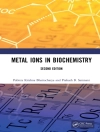Micro-Mesoporous Metallosilicates
Up-to-date and in-depth text bridging the technology gap between fundamental research and industry-scale applications of porous materials for catalysis
Micro-Mesoporous Metallosilicates: Synthesis, Characterization, and Catalytic Applications comprehensively introduces the chemistry and catalytic technologies of metallosilicates, an important family of microporous crystalline zeolite and heteroatom-containing mesoporous materials, with a primary focus on design synthesis, characterization, theoretical studies, and catalytic applications of titanosilicates, tin-silicates, germanosilicates and Ti-mesosilica, and more.
The text covers recent advances in the synthesis of titanosilicates, including hydrothermal synthesis, dry-gel conversion, fluoride-assisted synthesis, and post-synthesis methods, along with the synthesis of metallosilicates with two-dimensional lamellar structures and their structural modifications as well as applications in selective oxidation reactions.
The text also discusses synthesis of germanosilicates with specially designed organic structure-directing agents, synthesis and catalytic applications of heteroatom-containing mesoporous silica, and dendritic mesoporous silica nanoparticles with unique wrinkled center-radial structures.
Overall, every important porous metallosilicate and its synthesis, characterization, pore engineering, catalytic application, and industrial technique and process are covered.
Specific sample topics discussed in Micro-Mesoporous Metallosilicates include:
- Chemical post-modifications of titanosilicates, in terms of the effects on transfer, adsorption/desorption, and surface reactions
- X-Ray based techniques, ultraviolet-visible-near infrared spectroscopy, Raman spectroscopy, and solid-state NMR spectroscopy
- Theoretical calculation as an effective tool and supplement to understand the catalytic active center, structural character, and Brønsted/Lewis acidity
- Titanosilicates in the liquid-phase epoxidation reaction of propylene and propylene chloride to corresponding epoxides
- Effects of particle sizes, oxidation state, and location sites of Au nanoparticles, and epoxidation performance of Ti-containing materials
Delivering cutting-edge research and bridging the technology gap between fundamental research and industrial applications, Micro-Mesoporous Metallosilicates is a valuable resource for chemists, materials scientists, chemical engineers, and experienced researchers in related fields.
Daftar Isi
Preface xv
1 Synthesis of Titanosilicates 1
Xinqing Lu
1.1 Introduction 1
1.2 Synthesis of Medium-Pore Titanosilicates 5
1.2.1 TS-1 Synthesis 5
1.2.2 Ti-MWW Synthesis 6
1.2.3 TS-2 Synthesis 8
1.2.4 Synthesis of Other Medium-Pore Titanosilicates 9
1.3 Synthesis of Large-Pore Titanosilicates 9
1.3.1 Ti-Beta Synthesis 9
1.3.2 Ti-MOR Synthesis 10
1.3.3 Ti-MSE Synthesis 12
1.3.4 Synthesis of Other Large-Pore Titanosilicates 13
1.4 Synthesis of Extra-Large-Pore Titanosilicates 14
1.5 Synthesis of Mesoporous Titanosilicates 15
1.6 Synthesis of ETSs 17
1.7 Conclusions 18
References 18
2 Layered Heteroatom-Containing Zeolites 31
Hao Xu and Peng Wu
2.1 Introduction 31
2.2 Traditional Layered Heteroatom-Containing Zeolites 32
2.2.1 Heteroatom-Containing MWW-Type Layered Zeolites and Their Derivative Zeolitic Materials 32
2.2.2 Heteroatom-Containing Layered Zeolites Built from fer-Layers 36
2.3 Novel Layered Heteroatom-Containing Zeolites 41
2.3.1 Heteroatom-Containing MFI-Type Layered Zeolites 41
2.3.2 Germanosilicate-Derived Heteroatom-Containing Zeolites 44
2.4 Conclusions 45
Acknowledgments 46
References 46
3 Synthesis and Catalytic Applications of Sn- and Zr-Zeolites 53
Zhiguo Zhu
3.1 Introduction 53
3.2 Synthesis of Sn- and Zr-Zeolites 55
3.2.1 Bottom-up Approaches 56
3.2.2 Top-Down Approaches 63
3.3 General Remarks 66
3.4 Catalytic Applications of Sn- and Zr-Zeolites 67
3.4.1 Redox Catalysis 68
3.4.2 Lewis Acid Catalysis 71
3.4.3 Biomass Conversion 73
3.5 General Remarks 78
References 79
4 Synthesis of Germanosilicates 87
Jiuxing Jiang
4.1 Introduction 87
4.1.1 General Property of Ge/Si Oxides 87
4.1.2 Germanosilicate Glass 88
4.2 Isomorphous Substitution in Germanosilicates 89
4.2.1 Isomorphous Substitution Si in Germanate 89
4.2.2 Isomorphous Substitution Ge in Silicates 92
4.3 Inorganic Structure-Directing Effects 93
4.3.1 Structure-Directing Effects of Ge 93
4.3.2 Structure-Directing Effects of F− 94
4.4 Organic Structure-Directing Agents in Germanosilicate Synthesis 94
4.4.1 Organic Structure-Directing Agent Types and Revolutions 94
4.4.2 Two Important Families of OSDA 95
4.5 Structure Diversity of Germanosilicates/Silicogermanates 106
4.5.1 Relationship Between Composition and Structure 106
4.5.2 Pore Opening 106
4.6 Possibility of Elimination of Ge and Catalytic Research of Germanosilicates 108
4.6.1 The Price Concern of Ge 108
4.6.2 Removal of Ge in Zeolite Synthesis 108
4.6.3 Removal of Ge with Post-synthesis 109
4.6.4 Catalytic Research of Germanosilicates 112
4.7 Conclusions and Outlook 112
References 112
5 Structural Modifications on Germanosilicates 119
Ondřej Veselý, Maksym Opanasenko, and Jǐrí Čejka
5.1 Introduction 119
5.2 Germanosilicates to Layered Precursors 121
5.2.1 UTL to IPC-1P 121
5.3 ADOR Strategy for Developing New Zeolite Structures 125
5.3.1 Assembly 126
5.3.2 Disassembly 127
5.3.3 Organization 127
5.3.4 Reassembly 127
5.3.5 Liquid-phase ADOR 128
5.3.6 Vapor-phase ADOR 135
5.3.7 Reductive Degermanation 136
5.3.8 Solid-state Transformations 137
5.4 Structure Stabilization 139
5.4.1 Degermanation 139
5.4.2 Functionalization With Catalytic Sites 140
5.4.3 Slow Disassembly 141
5.4.4 Reverse ADOR 141
5.5 Germanosilicate-Derived Catalysts 142
5.5.1 Summary and Perspectives 144
Acknowledgements 146
References 146
6 Heteroatom-Containing Dendritic Mesoporous Silica Nanoparticles 153
Bo Peng, Jia-Feng Zhou, Meng Ding, Laurent Bonneviot, and Kun Zhang
6.1 Introduction 153
6.2 Main Synthetic Methods and Formation Mechanism of Pure Silica-Based Dendritic Mesoporous Silica Nanoparticles (DMSNs) 155
6.2.1 Main Synthetic Methods of Dendritic Mesoporous Silica Nanoparticles (DMSNs) 155
6.2.2 Unified Formation Mechanism of Dendritic Mesoporous Silica Nanoparticles 155
6.3 Synthesis of Heteroatom-Containing DMSNs and Their Catalytic Applications 164
6.3.1 One-Pot Doping Strategy for DMSNs Containing Heteroatoms (Al/Ti/V/Sn/Mn/Fe/Co) 165
6.3.2 Post-grafting for Surface Metal Complexes 167
6.3.3 Loading of Metal and/or Metal Oxide Nanoparticles Within the Nanopores 169
6.4 Summary and Perspectives 173
Acknowledgments 173
References 173
7 Chemical Post-Modifications of Titanosilicates 181
Fang Nan, Liu Dongxu, Yu Yunkai, and Liu Yueming
7.1 Introduction 181
7.2 Diffusion and Adsorption/Desorption 182
7.2.1 Hierarchical Titanosilicates 182
7.2.2 Surface Hydrophilicity and Hydrophobicity 183
7.3 Surface Reaction 184
7.3.1 Ti Active Sites Content 184
7.3.2 Ti Active Sites Distribution 186
7.3.3 Ti Active Sites Properties 187
7.4 Solvent Effect 196
7.4.1 Effect of Solvent on Diffusion 197
7.4.2 Effect of Solvent on Adsorption/Desorption 199
7.4.3 Effect of Solvent on Surface Reactions 200
7.5 Conclusions and Prospects 204
References 204
8 Spectroscopic Characterization of Heteroatom-Containing Zeolites 217
Guodong Qi, Jun Xu, and Feng Deng
8.1 X-Ray Technique 217
8.1.1 XRD Determination of Framework Structure and Heteroatoms in Zeolites 217
8.1.2 XAS Characterization of Metals in Zeolite 219
8.1.3 XPS Analysis of the Chemical State of Metal Species 222
8.2 Ultraviolet–Visible-Near Infrared (UV–VIS–NIR) Spectroscopy 224
8.2.1 UV–VIS–NIR Characterization of Framework and Non-Framework Metal Species 224
8.2.2 UV–VIS–NIR Characterization of Metal Species on Ion Exchange Sites of Zeolites 226
8.3 Raman Spectroscopy 227
8.3.1 Raman Study of Synthesis Mechanism and Assembly of Metal-Zeolites 228
8.3.2 Raman Characterization of Active Metal-Oxygen Species in Zeolites 228
8.4 Solid-State NMR Spectroscopy 230
8.4.1 Solid-State NMR Characterization of Metal Elements in Zeolites 231
8.4.2 Solid-State Correlation NMR Measurement of Active Site Proximity and Host–Guest Interactions 233
8.4.3 In Situ Solid-State NMR for the Study of Reaction Mechanisms 235
8.5 Conclusions 238
Acknowledgments 239
References 239
9 Theoretical Calculations of Heteroatom Substituted Zeolites 253
Xin Yu, Wenjun Dong, Wei Chen, and Anmin Zheng
9.1 Introduction 253
9.2 Ti-Doped Zeolites 254
9.2.1 Preferred Tetrahedral (T) Sites for Substitution 255
9.2.2 Lewis Acid 257
9.2.3 Active Site with H2O2 258
9.2.4 Reaction Mechanism 261
9.3 Sn-Doped Zeolites 267
9.3.1 Preferred Substitution T Sites and Acidity 267
9.3.2 Reaction Mechanism 268
9.3.3 Other Catalytic Reactions 272
9.4 Other Metal-Substituted Zeolites 273
9.5 Summary and Outlook 276
Acknowledgments 276
References 277
10 Catalytic Ammoximation of Ketones or Aldehydes Using Titanosilicates 283
Rusi Peng, Hao Xu, Chengwei Zhai, Mingyuan He, and Peng Wu
10.1 Introduction 283
10.2 The Development of Titanosilicates in Ammoximation of Ketones and Aldehydes 284
10.3 Ammoximation Mechanism and Product Distributions of Representative Ketones and Aldehydes 288
10.3.1 Titanosilicate-Catalyzed Ammoximation Mechanism 288
10.3.2 Product Distributions for Ammoximation of Representative Carbonyl Compounds 290
10.4 Enhancing Ammoximation Performances in Titanosilicate/H2O2 System 295
10.4.1 Improvement of Catalytic Ammoximation Activity 296
10.4.2 Improvement of Catalytic Ammoximation Stability 300
10.5 Ketone Ammoximation Technology for Industrial Processes 302
10.6 Titanosilicate-Based Bifunctional Catalysts for Process Intensified or Tandem Ammoximation Reactions 306
10.7 Conclusions and Perspectives 310
Acknowledgments 311
References 311
11 Titanosilicate-Based Alkene Epoxidation Catalysis 323
Changjiu Xia and Xiang Feng
11.1 Introduction 323
11.2 Reaction Chemistry of Alkene Epoxidation Catalyzed by Titanosilicate Zeolites 326
11.3 Typical Alkene Epoxidation Cases 329
11.3.1 Propylene Epoxidation for PO Production 329
11.3.2 Propylene Chloride Epoxidation 331
11.3.3 Ethylene Epoxidation to EO, EG, and Ethers 334
11.4 Industrial Propylene Epoxidation Techniques and Processes 336
11.5 Conclusion and Outlook 339
Acknowledgments 339
References 340
12 Propylene Epoxidation with Cumene Hydroperoxide/Titanosilicates 345
Le Xu and Hailang Liu
12.1 Introduction 345
12.2 Traditional Route for PO Production (Chlorohydrin Process) 347
12.3 Co-production Route for PO Production (PO/TBA and PO/SM Processes) 347
12.4 PO-Only Production Routes (HPPO and CMHPPO Routes) 349
12.5 Catalyst Design for PO-Only Routes 350
12.5.1 Mesoporous Ti-Doped Catalysts for CMHPPO Process 352
12.5.2 Hierarchical Titanosilicates for CMHPPO Process 357
12.6 Industrial CMHPPO Process 362
12.7 Conclusions and Outlooks 363
References 364
13 Hydroxylation of Benzene and Phenol on Zeolite Catalysts 367
Shiying Li, Shanhui Zhu, Sen Wang, Mei Dong, and Weibin Fan
13.1 Introduction 367
13.2 Hydroxylation of Benzene to Phenol 368
13.2.1 Gas-Phase Reactions 368
13.2.2 Liquid-Phase Reactions 378
13.3 Hydroxylation of Phenol to DHB 381
13.3.1 Fe-Containing Molecular Sieves as Catalysts 382
13.3.2 Titanosilicate Molecular Sieves as Catalysts 387
13.3.3 Transition Metal Complexes Encapsulated in Zeolite Y as Catalysts 393
13.4 Summary 394
Acknowledgments 395
References 395
14 Bifunctional Titanosilicate Systems for the Gas-Phase Catalytic Propylene Epoxidation with Hydrogen and Oxygen 403
Gang Wang, Qianhong Wang, Zhihua Zhang, Xuezhi Duan, and Xinggui Zhou
14.1 Introduction 403
14.2 Advances in the Catalytic Propylene Epoxidation with H2 and O2 404
14.2.1 Mechanistic Insights into Au-Ti Synergy 404
14.2.2 Effects of Au Particle Properties 406
14.2.3 Effects of Materials’ Properties for Immobilizing Au Particles 408
14.2.4 Effect of Promoters 413
14.3 Conclusions and Outlook 415
Conflicts of Interest 416
References 416
15 Zeolites Containing Heteroatoms/Metal Nanoparticles for Catalytic Conversion of Light Alkanes 423
Hang Zhou, Liang Wang, and Feng-Shou Xiao
15.1 Introduction 423
15.2 Metal Nanoclusters and Heteroatoms in Zeolite for Propane Dehydrogenation 424
15.2.1 Zeolite-Based Catalysts for Non-Oxidative PDH 425
15.2.2 Zeolite-Based Catalysts for Oxidative PDH 426
15.3 Metallosilicates for Ethane Dehydrogenation 430
15.3.1 Metallosilicates for Non-Oxidative Dehydrogenation of Ethane 430
15.3.2 Metallosilicates for Oxidative Dehydrogenation of Ethane 431
15.4 Zeolite Catalysts for Selective Oxidation of Methane 432
15.4.1 Bionic Catalysis of Methane to Methanol Using Metallosilicates 434
15.4.2 In situ Synthesizing Hydrogen Peroxide for Low-Temperature Methane Oxidation Using Metal@zeolite 435
15.4.3 Direct Metal Oxidation with Oxygen by Zeolite-Supported Nanoparticle Catalysts 436
15.5 Summary and Outlook 439
Acknowledgments 440
References 440
16 Design and Applications of Single-Site Photocatalysis Using Metallosilicates 447
Priyanka Verma and Hiromi Yamashita
16.1 Introduction 447
16.2 Ti-Based Single-Site Photocatalysis Within Zeolites and Mesoporous Silica 449
16.3 Single-Site Photocatalysis Based Thin Films 450
16.3.1 Thin Films with Ti-Oxide Species 450
16.3.2 Thin Films with Various Metal Oxide Species (Mo, V, Cr, and W) 452
16.4 Visible-Light Sensitive Single-Site Photocatalysis 454
16.5 Nano-Sized Metal Preparation Using Single-Site Photocatalyst 456
16.5.1 Preparation of Monometallic NPs 456
16.5.2 Preparation of Bimetallic Metal NPs 457
16.6 Conclusions 458
Acknowledgments 461
References 461
Index 465
Tentang Penulis
Peng Wu, Ph D, is a Professor in School of Chemistry and Molecular Engineering at East China Normal University. His research interests focus on design, functionalization, and catalytic applications of novel zeolites.
Hao Xu, Ph D, is a Professor in School of Chemistry and Molecular Engineering at East China Normal University. Her research interests focus on the design and synthesis of novel zeolite catalysts via post modifications












